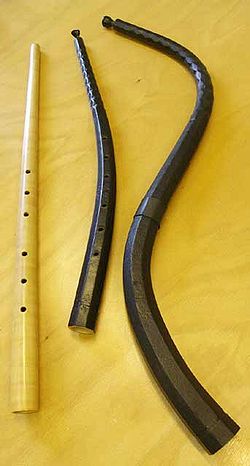 Three different cornetts: mute cornett, curved cornett and tenor cornett. | |
| Brass instrument | |
|---|---|
| Classification | Brass instrument Horn |
| Hornbostel–Sachs classification | 423.212 (Lip-reed aerophone with tone holes or keys and irregular/moderately conical bore) |
| Developed | Since antiquity; from instruments made from animal bone or horn with finger holes, such as the coradoiz[1] |
| Playing range | |
 | |
| Related instruments | |
| Musicians | |
| |
| Builders | |
The cornett (Italian: cornetto, German: Zink) is a lip-reed wind instrument that dates from the Medieval, Renaissance and Baroque periods, popular from 1500 to 1650.[9] Although smaller and larger sizes were made in both straight and curved forms, surviving cornetts are mostly curved, built in the treble size from 51 to 63 cm (20 to 25 in) in length, usually described as in G. The note sounded with all finger-holes covered is A3, which can be lowered a further whole tone to G by slackening the embouchure. The name cornett comes from the Italian cornetto, meaning "small horn".
It was used in performances by professional musicians for both state and liturgical music, especially accompanying choral music. It also featured in popular music in alta capella or loud wind ensembles.[10] British organologist Anthony Baines wrote that the cornett "was praised in the very terms that were to be bestowed upon the oboe [...]: it could be sounded as loud as a trumpet and as soft as a recorder, and its tone approached that of the human voice more nearly than that of any other instrument."[11] It was popular in Germany, where trumpet-playing was restricted to professional trumpet guild members.[12] As well, the mute cornett variant was a quiet instrument, playing "gentle, soft and sweet."[13]
The cornett is not to be confused with the modern cornet, a valved brass instrument with a separate origin and development.[12] The English spelling cornet, which had applied to the cornett since about 1400, was in around 1836 transferred to the cornet à pistons, the predecessor of the modern cornet.[14][15] Subsequently, cornett became the modern English spelling of the older instrument.[16]
- ^ Marcuse 1975, p. 124, "Coradoiz".
- ^ Herbert, Myers & Wallace 2019, p. 490, Appendix 2: The Ranges of Labrosones.
- ^ Simian, Ricardo. "Ordering a cornetto". 3D Music Instruments. Retrieved 11 October 2024.
- ^ Heller, Fritz. "Gerade Zinken". Instrumentenbauer Fritz Heller (in German). Retrieved 11 October 2024.
- ^ Hathaway, Daniel (21 June 2010). "A Conversation with cornetto virtuoso Bruce Dickey". Cleveland Classical. Retrieved 11 October 2024.
Well, there are about four good makers, the best of which is a fellow in Montreal, Matt Jennejohn.
- ^ "Christopher Monk Instruments". Jeremy West. Retrieved 10 October 2024.
- ^ Tomaszewicz, Grzegorz (2024). "Price List". GT Instruments. Retrieved 11 October 2024.
- ^ van der Veen, Siem (2024). "Zink Cornetto". Zink Cornetto (in Dutch). Retrieved 11 October 2024.
- ^ "Zink". Dictionary.com. Retrieved 2012-05-26.
- ^ Brown, Howard; Polk, Keith (2001). "Alta (i)". Grove Music Online (8th ed.). Oxford University Press. doi:10.1093/gmo/9781561592630.article.00676. ISBN 978-1-56159-263-0. Retrieved 29 October 2024.
alta musique (Fr.) or 'loud music' as opposed to basse musique, 'soft music'
- ^ Baines, Anthony (1957). Woodwind Instruments and Their History. New York: W. W. Norton & Company, Inc. pp. 259–60. ISBN 9780486268859.
- ^ a b Marcuse 1975, p. 128–129, "Cornett".
- ^ Marcuse 1975, p. 354, "Mute cornett".
- ^ "cornet à piston". Oxford English Dictionary (Online ed.). Oxford University Press. (Subscription or participating institution membership required.)
- ^ "cornet". Oxford English Dictionary (Online ed.). Oxford University Press. (Subscription or participating institution membership required.)
- ^ Marcuse 1975, p. 128, "Cornett"; "Its correct Engl. name, 'cornet' [...] having been bestowed on a modern brass instrument, the word is nowadays customarily written 'cornett.'".